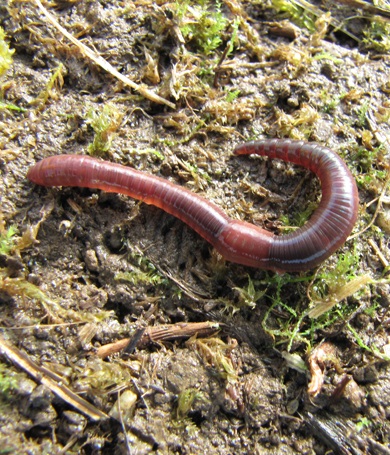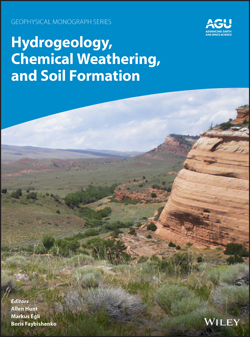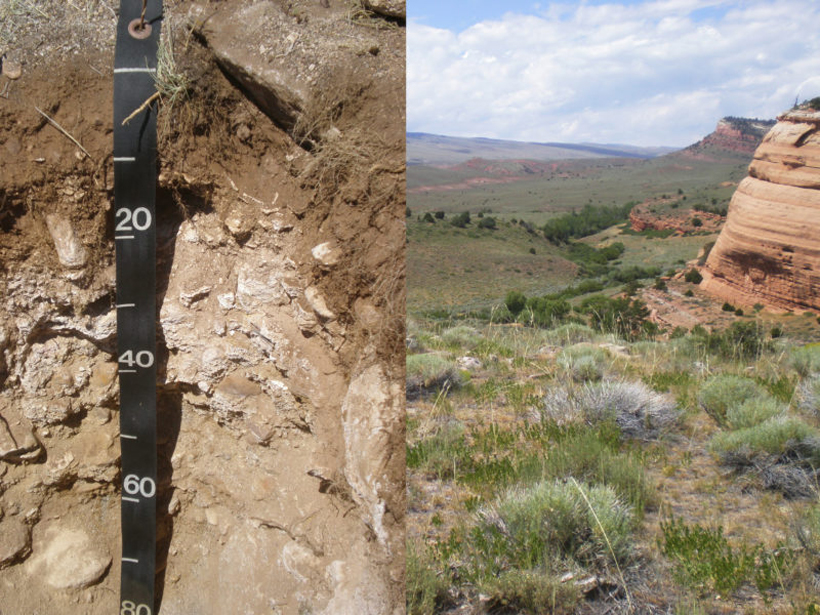Soil is a narrow but critically important zone on Earth’s surface. It is the interface for water and carbon recycling from above and part of the cycling of sediment and rock from below. Hydrogeology, Chemical Weathering, and Soil Formation, a book recently published by AGU, places chemical weathering and soil formation in its geological, climatological, biological, and hydrological perspective. Here the book’s editors give an overview of what we know about soil formation and advances in our understanding of this complex system.
Why is it important to understand how soil forms and evolves?
Bilbo Baggins, the Hobbit, had to solve a riddle that, if changed slightly, refers to soil rather than to time:
This thing all things devours:
Birds, beasts, trees, flowers;
Gnaws iron, bites steel;
Grinds hard stones to meal;
Rots king, buries town,
And strips high mountain down.
Beyond that, soil is a foundation for agriculture, buildings, and a receptacle for some waste. It helps to purify and store water and carbon. It is the most complicated biomaterial (ecosystem) on the planet, sometimes called the crucible of life, said to act like a composite living entity. It may be the birthplace of Gaia, if such exists, and it is the source of climate regulation. Its geologic appearance records climates. Its erosion clogs rivers, its formation draws down carbon, and its formation and erosion may be a limit to the rock cycle.
What are the basic processes that contribute to soil formation?
Flowing water is one critical process contributing to soil formation. Combined with the structure of the medium, this flow defines a fundamental time scale of soil formation. However, the range of coupled processes, physical, biochemical, and geological, introduces many interdependent rates and times.

Which process is limiting?
Is it the physical weathering of the bedrock to allow pathways for roots to grow and the separation of particles to form soil?
Is it biogeochemical weathering of the bedrock that drives (micro)fracture formation to let the water in and alter minerals to their soil products?
Is it the time to establish biota that allows modification of surface waters to drive chemical weathering?
Is it the formation of soil from weathered products that allows the plants to grow?
Can we break this circularity in inquiry, or does it reflect a fundamental reality that makes soil an inscrutable system?
And where does soil rearrangement from rodents, arthropods, Darwin’s earthworms, or others, fit in?
In your book title, why did you choose to link soil formation with hydrogeology?
The partitioning of infiltrating water or evapotranspiration fluxes between soil and vegetation, along with the contribution of groundwater, is the central topic of the soil water balance. Each of these fluxes couples with the carbon cycle as well. We need to understand the relationships between these water fluxes, as is recognized by several relevant NSF programs and their relationships to soil formation, chemical weathering and net primary productivity.
Ultimately the process of weathering and soil formation couples with the rock cycle, too. Regarding the effect of the water flux and water partitioning: there is a Russian proverb: Вода камень точит, which is translated to “Water wears away a stone” or “Water dripping day by day wears the hardest rock away.”
What have been some recent advances in our understanding of soil formation?
That’s difficult to summarize given the diversity of scientific fields that intersect with soil. However, we would highlight:
- Understanding bedrock fracturing. Recent research found that tree roots cannot ordinarily supply the necessary stress, but mineral volume changes under chemical weathering can propagate fractures into bedrock.
- The strong correlation found between chemical weathering and soil formation rates. Some field results indicate a strong correlation of soil formation with precipitation, although the comparison was with the ratio of precipitation to temperature, whereas groundwater flow rates correlate with the difference of precipitation and evapotranspiration. This is important since groundwater flow rates definitely correlate with chemical weathering and carbon sequestration rates.
- Symbiosis between fungi and plant roots enhances nutrient uptake but depends on the fungal community.
- Relationships between chemical weathering and transport-limited reactions as well as between soil formation and the water balance.
Why is it important to study soil using a multidisciplinary perspective, taking into account the geological, climatological, biological, and hydrological contexts?
Soil is a very complex system, thus there is a need to coordinate research across disciplines.
Soil is a very complex system, thus there is a need to coordinate research across disciplines. One challenge is that each discipline uses different language and concepts to approach the topic which can inhibit mutual understanding and collaboration.
The relationship of soil to geology and other related disciplinary perspectives is more a question of how understanding soil formation processes, variables, and rates informs interpretation of paleosol records of paleoclimates and the history of the Earth. In principle, however, as Earth’s climate and biota change, a perspective of the geological history as a record of the preservation of deep-time Critical Zone Observatories can allow investigations that isolate some of the variables involved in overall soil formation, such as atmospheric composition and plant structural characteristics, as well as the roles of animal communities inhabiting the soil, from worms to arthropods on up, thus using geobiology and geochemistry to aid in understanding biology and climate.
What is particularly novel about the material presented in your new book?
Our volume places the topic of soil formation within geological, climatological, biological, and hydrological perspectives, including examples from Earth’s history.
We also present some fundamentals of soil formation and development. Chemical weathering is the engine of soil formation. Although soil formation is certainly a very complex process, there is increasing evidence that the water flux and water partitioning are key factors controlling chemical weathering, even in very cold climates, and, thus, the evolution and spatio-temporal behavior of soil and related biosphere.
This knowledge is fundamental for modeling, prediction, and understanding nutrient fluxes. As soon as habitats for organisms are created, they act as engineers and help in providing the numerous ecosystem services of soils. These services are prone to irreversible changes and damages when land management is not adjusted. Adverse changes caused by land use strongly affect organic carbon sequestration rates and give rise to a negative feedback to the carbon cycle and thus climate.
What are some of the unresolved questions where additional research, data, or modeling is needed?

To stimulate future research, we hypothesize that weathering, erosion, soil formation, and biogeochemical cycling are essentially limited by water fluxes.
Additional research or modeling needs to answer the question: To what extent is the conventional understanding of chemical weathering based on traditional concepts of soil physics and soil chemistry? Chemical weathering is a complex biogeochemical process that depends on the CO2 and organic acids released by the plants. The productivity of plants is, however, controlled by water availability and nutrients. It is still challenging to define under which conditions mineral weathering is controlled by water percolation or when its behavior relates more simply to reaction kinetics.
Beyond the question of limits to theoretical understanding, where is our conceptual understanding most strongly limited, in hypotheses or information [Harpold et al., 2014; Parsekian et al., 2014]? Do we have rational definitions for the spatial limits of the soil and the critical zone?
Hydrogeology, Chemical Weathering, and Soil Formation, 2021, DOI:10.1002/9781119563952, list price, $199.95 (hardcover), $160.00 (e-book)
—Allen Hunt ([email protected], ![]() 0000-0002-3074-4946), Wright State University, USA; Markus Egli (
0000-0002-3074-4946), Wright State University, USA; Markus Egli (![]() 0000-0002-1528-3440), University of Zürich, Switzerland; and Boris Faybishenko (
0000-0002-1528-3440), University of Zürich, Switzerland; and Boris Faybishenko (![]() 0000-0003-0085-8499), Lawrence Berkeley National Laboratory, USA
0000-0003-0085-8499), Lawrence Berkeley National Laboratory, USA
Editor’s Note: It is the policy of AGU Publications to invite the authors or editors of newly published books to write a summary for Eos Editors’ Vox.
Citation:
Hunt, A. G.,Egli, M., and Faybishenko, B. A. (2021), Exploring the engine and drivers of soil formation, Eos, 102, https://doi.org/10.1029/2021EO154907. Published on 26 February 2021.
Text © 2021. The authors. CC BY-NC-ND 3.0
Except where otherwise noted, images are subject to copyright. Any reuse without express permission from the copyright owner is prohibited.

